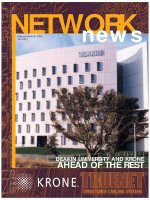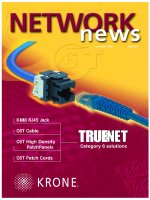Tài liệu ADC KRONE Network News - Vol.11 No.2 - 2004 docx
Bạn đang xem bản rút gọn của tài liệu. Xem và tải ngay bản đầy đủ của tài liệu tại đây (2.02 MB, 16 trang )
PLUS . . .
UNLEASHING THE POWER
OF THE NETWORK!
GOING THE WHOLE NINE YARDS
KRONE SAILS THE HIGH SEAS!
Vol11 No2 2004
O
O
O
O
CopperTen
™
O
ver the past quarter, KRONE has focused
on taking our message to the
marketplace. Kicking off with a national
roadshow in March, we took to the road in an
effort to bring our latest technologies and
innovations to you. Thank you to those of you
who were able to attend and spare the time to
learn more about KRONE’s latest
developments.
I’m pleased to announce CopperTen
™
, the
world’s first augmented Category 6 structured
cabling system with the necessary
characteristics to enable 10 Gigabit UTP
transmission over a full 100 metres. By
serving-up a more cost effective and easier to install
solution to fibre optics or shielded cabling, KRONE will
once again revolutionise the future of networking
forever. Stay tuned for further details on the release of
this exciting development.
On page 4 of this issue, Robert Milne reviews the
rapid emergence of IP technologies and explains the
importance of a solid high-quality cabling installation in
next generation networks.
Continuing on the theme of emerging technologies,
Peter Meijer, our Technical Training Manager and
Industry Liaison, takes us through the pros and cons of
10 Gigabit Ethernet on page 8.
Also inside, we look at several customer solutions
including popular National Soccer League Club,
Marconi. A report on the new cabling standard for the
Catholic Schools Office. As well as the successful
deployment of an innovative HIGHBAND
®
25 system at
Utah’s State University and the rather challenging and
somewhat unique installation on-board a seismic
research vessel.
Our recent attendance at the Cisco Networkers
conference in Brisbane continues our efforts to bring
our message to you. More details on what was a very
successful event can be found on page 3.
KRONE will also be attending Australia’s major ICT
event, CeBIT Australia in May. Our team of sales
executives and product specialists will be on hand to
explain our latest technologies and answer any queries
you may have. Further information on the CeBIT
exhibition can be found on page 16.
We look forward to seeing you out in the
marketplace.
Sincerely
Craig Jones
CEO
2
\
NETWORKnews
BREAKING THE WORLD
LAN-SPEED RECORD
Bringing you the latest in emerging high-performance technologies
Customer Stories
6 KRONE Sails the High Seas!
10 New Network Kicks a Goal
for Club Marconi
12 Broken Bay Harmonises Diocese
Network
14 HIGHBAND 25 Becomes Big Man
on Campus
Standards Update
8 10GB Ethernet on Optical Fibre
KRONE News
3 Unleashing the Power of
the Network
3 CopperTen A World First!!
16 World First At CeBIT '04
16 Getting Their Feet Wet
Business Articles
4 Going the Whole Nine Yards
Website: krone.com.au
Email:
Editor: Joanna Parsons
Art Direction: Nora Collins
Copyright © 2001 KRONE (Australia) Holdings Pty. Limited
CONTENTS
NETWORKnews
\
3
By Trevor Kleinert, RCDD,
National Sales Manager
Premis
NET
, Manager
Fibre Optics Division,
KRONE Australia
A
s a registered Cisco
®
partner, KRONE attended and
exhibited at Cisco’s premier event held in Brisbane
for customers and partners, the 12th annual
Networkers Conference, 2004.
Networkers provided the ideal opportunity and
forum for all people involved in the use,
implementation and configuration of Cisco products to
gain in-depth knowledge of Cisco’s latest products and
technologies. With 900+ delegates, 40 exhibitors, over
70 training sessions and presentations provided on the
hottest networking topics, combined with the
opportunity to network with our peers, colleagues and
other partners, this was the industry event to attend!
The theme of the conference was “The Power of the
Network. Now”. The keynote speakers outlined how
networks can enable breakthrough productivity in the
order of 25% to 30% improvement.
Cisco also outlined their technology vision for the
next three to five years based on the building and
securing of the intelligent information network. It was
outlined how through a systems approach, greater
capability and intelligence would be migrated to the
network layer to evolve an intelligent and unified
network infrastructure.
For KRONE, at the very base of the network pyramid
providing layer one connectivity solutions, this
reinforces the need for product of the highest quality
and performance, as only KRONE can provide. KRONE
products providing for a solid foundation enabling
Cisco and its customers to realise this powerful,
connected network vision.
With the KRONE range on display, this message was
reinforced through the delegates high level of interest
in our HIGHBAND
®
25 Category 6 and fibre
connectivity products. Each of these representing the
highest quality products in each market segment.
HIGHBAND 25 utilising Patch By Exception being an
ideal solution for organisations wishing to implement
VoIP to save money in space, management, patch
cordage, rack equipment whilst ensuring maximum
performance and zero bit errors to prevent issues with
voice quality.
Further KRONE's CopperTen, 10Gb solution sparked
interest from a number of Cisco engineers who see this
technology allowing for the creation of a new
generation of high speed, cost effective copper based
products using current RJ45 connectivity, without the
need to move to an expensive Cat7, Terra connected
product range.
All in all a great show, great party (for all the Lara
Croft fans ) and with a concluding messaging from
Nando Parrado, who told the compelling story of
survival on the mountain peaks of the Andes, live for
Now!
Q
By Rob Milne,
Business Development
Manager,
KRONE Australia
During the month of March, KRONE kicked off its
national Generation NEXT 04 Roadshow. Aimed at
installers, end users, consultants and distributors, the
roadshows were designed to share KRONE’s latest
innovations and industry news with the marketplace.
The roadshows proved to be a great success with
strong audience participation in each of the major
capital cities. Thank you to those of you who were able
to attend and provide us with positive feedback on
KRONE’s latest technologies.
This was a great opportunity to provide customers
with an overview of the products KRONE has recently
introduced into the market, namely the new style
Category 6 FMK
™
Jack, Category 6 Patch Panel,
Category 6 Angled Patch Panel, Fibre-in-a-Box
™
and
the robust IP67 industrial range.
Rob Milne, KRONE Australia’s Business Development
Manager, was able to present audiences with an
interesting overview on the changing marketplace from
an IT Manager’s perspective, covering off the
continuing prevalence of IP convergence.
Peter Meijer, our Technical Training Manager and
Industry Liaison informed attendees on the latest
developments regarding 10 Gigabit applications and
the imminent release of our CopperTen
™
solution.
CopperTen is the word’s first augmented structured
cabling solution capable of transmitting 10 Gigabit
Ethernet over a full 100 metre channel.
The Generation NEXT 04 Roadshow provided our
customers with a preview of this revolutionary new
technology to be unveiled at CeBIT in May.
Q
CopperTen
™
A WORLD FIRST!!
UNLEASHING THE POWER
OF THE NETWORK!
A
s preparations are made for the Athens Olympics,
it does not seem so long ago when Sydney was
getting ready for its turn on the international stage.
However, in terms of IT systems and network
technologies, four years appears to be almost a
lifetime!
Consider the current state of voice and data
networks, and the applications they support, compared
to that of four years ago. The most significant change
has been the expansion of IP based technologies from
predominantly supporting data and now to
technologies as diverse as voice, video, storage, security
and building automation; and there are others currently
under development. How many people had heard of
the VoIP word four years ago? Who would have
thought that Cisco
®
would be vying for number one
spot as a telephone systems provider?
The main driver behind this rapid technological shift
has been the expansion of application diversity and
functionality; with the internet at the centre. Business
collaboration, supply chain communication and an
increase in economic “velocity” have been key to
bringing about these changes. But as applications
become more complex and diverse, the need to reduce
the cost of supporting, managing and deploying them
is also under considerable pressure; so as to reduce the
costs of doing business. Enter IP, or more correctly
TCP/IP, as the network transport layer, or the glue
beneath the applications.
IP offers the advantage of one technology, one set of
rules and one basis of knowledge required by IT people
who implement, support and operate modern
applications. Contrast this against the diverse
knowledge requirements of disparate, older
technologies like analogue voice, video, direct attach
storage, requiring individual specialisation in each
technology; support costs of which IT departments
today can ill afford.
With the move to IP based networking technologies
has been the corresponding impact on the underlying
cabling and connectivity infrastructure. In the past,
whilst using the same connectivity components,
different network topologies were deployed. Separate
networks were deployed for voice and data (see fig.
OLD). This also provided for a measure of redundancy if
a problem occurred on either network.
Today however for a converged IP network there is only
one technology, one protocol and one network!
4
\
NETWORKnews
GOING THE WHOLE NINE YARDS
Create a next generation IP converged network with ten nines reliability.
By Rob Milne, Business
Development Manager,
KRONE Australia
Traditional, analogue TDM voice networks had
evolved to a point where 99.999% availability and
reliability was the norm. Contrast this with a typical
data network where 99.9% is standard. What does
99.999% reliability mean? It means absolute minimum
downtime in terms of calls being dropped, inability to
place calls or where call quality is poor to the point of
being untenable. Five nines equates to less that 5.26
minutes of downtime in a year of operation. Clearly
this is an admirable target, and in mission critical,
realtime applications such as voice networks; a
necessity.
For a data network based on TCP/IP, the TCP
(Transmission Control Protocol) ensures resilience in the
data being able to travel from its source to the
intended destination and arrive in the form it was sent.
If a packet is dropped due to a network problem or
congestion, then it will be re-transmitted until it arrives
correctly at its destination, just as it left. This means
that for a data application, continual packet drops and
retransmissions will manifest themselves in an
application that appears to be running slower, but
nevertheless still functioning.
For a realtime voice network running over TCP/IP
however, where a conversation is broken up over many
packets, packet loss will directly result in a loss of voice
quality, after all there is only so much of an ongoing
conversation which can be re-transmitted before a
delay is noticed by both parties at each end of the call.
Sub-standard installation practices, low quality and
poorly matched cable and components, will cause
more network faults than you would ever wish to
trouble-shoot. Such faults will produce data errors, re-
transmissions and collisions as well as other
(apparently) transparent problems, resulting in what we
all know as a “slow” network for applications. For
voice and video, however loss of quality to the point of
failure will be the result. Whilst an IP network may
appear to be 100% “up” to a data application, it may
not be delivering good IP telephony performance if
there is packet loss and excessive delays affecting voice
quality and reliability.
Whilst a converged IP network can deliver
tremendous savings in application integration,
management and support, nevertheless they are
complex systems and there is much upfront investment
involved in the initial design and installation of the
network environment. When problems occur many
network layers may need to be traversed to diagnose
and fix the problem. It would be an IT manager’s
nightmare to spend many hours and consulting dollars
to find a faulty connector or patch cord to be the
culprit. Particularly if someone had tried to save a dollar
by buying an inferior quality cord.
Before implementing your
next generation converged IP
network, consider carefully
the foundation you will build it
upon. If you want five nines
(99.999%) reliability, the professional
installation of a standards compliant,
TrueNet
®
network is the answer. Only
TrueNet offers a guarantee of a zero bit
error rate, essential to ensure errors are
not incurred from the structured cabling
system employed. Other cabling
warranties offer “application assurance”. All
this really means is that the link light will go on. It does
not ensure that the network will run efficiently. With
TrueNet, you can be assured that your new cabling
system channel will not cause bit errors which rob your
data applications of throughput or your IP voice/video
system of quality.
TrueNet offers this remarkable guarantee because it
is designed and tested using active network technology
that can evaluate the performance of a new cabling
system as if there were a live network in place. This
ensures that not only the TIA/EIA passive criteria are
met, but also the IEEE specifications, which are critical
for throughput performance. Testing parameters
included are jitter, CRC errors and oversized/undersized
packets, parameters that are absolutely critical to
ensure quality, IP telephony. Zero bit errors in the
warranty refers to an error rate of 10-12th, or
99.99999999% (ten nines reliability), far surpassing
the industry acceptance of five nines!
Q
NETWORKnews
\
5
Diagrams
Top: Impedence
mismatched channel.
Bottom: TrueNet
impedence matched
channel.
U
pgrading the cabling infrastructure of a ship would
probably be classed by most installers as an unusual
project. But one that was site unseen and still off-shore
at the time of tender, with only a five day window to
complete an entire refit, over the Australia Day long
weekend might even be considered by some as
‘mission impossible’.
This was the task awaiting Total Cabling Solutions in
January 2004 as the Veritas Viking II approached
Fremantle Harbour in Perth for an important engine
and IT upgrade prior to commencing contractual
operations in Australian waters.
Veritas DGC Inc ,headquartered in Houston, are a
major provider of land, transition zone and marine-
based seismic data acquisition, seismic data processing,
and multi-client data sales to the petroleum industry.
With over 36 years of operating experience and more
than 3000 employees in 19 countries on six continents,
Veritas is considered a leader in advanced geophysical
technologies.
Prior to the Viking II’s arrival in Perth, Veritas were
seeking a cabling contractor in Western Australia to install
a structured cabling system on board the Viking II whilst
in dock at Fremantle within the tight deadline of five days.
At 306 feet long and 72 feet wide, the Veritas Viking
II is considered to be one of the largest, most powerful
and technically advanced seismic vessels in the industry
today. The Veritas Viking II contains the latest recording
system and communications technologies with the
cable upgrade providing a vital link in maintaining the
performance required to operate such high-level 2D,
3D and 4D marine acquisition programs.
KRONE endorsed installer, Total Cabling Solutions,
were successful in securing the project. Veritas chose
Total Cabling Solutions based on their prior experience
in completing complex installations and proven ability
to undertake a project within a tight deadline. Veritas
were also impressed with the company’s outstanding
track record. As winners of various industry accolades
including the NECA and ECA awards and BRW
Magazine’s Fast 100, Total Cabling Solutions have an
enviable reputation.
With a lead time of approximately one-and-a-half
weeks, pre-planning would prove to be a crucial factor
in completing the installation on time due to the range
of products required, many of which needed to be
ordered in advance from NSW.
With the client off shore, all of Total Cabling
Solutions correspondence regarding the project was
conducted via email or in some instances via telephone
calls to Veritas’ Texas office at 2am Perth time.
Total Cabling Solutions presented the KRONE
solution to Veritas based on availability and local
support, informing the Veritas engineers that KRONE
were the only manufacturer that would be able to
6
\
NETWORKnews
KRONE SAILS THE HIGH SEAS!
KRONE cable supports seismic research during recent IT upgrade of Veritas
DGC’s Viking II.
By Carl Holmes,
WA Sales Executive,
KRONE Australia
KRONE were the only manufacturer
that would be able to guarantee
delivery of the product within the
time constraints imposed.
guarantee delivery of the product
within the time constraints imposed.
Veritas specifications insisted on a
solution that comprised of marine
grade cable. To meet these
requirements, Total Cabling Solutions
selected KRONE Premis
NET
®
for the
installation.
Upon receiving Veritas’
notification to proceed with the
project, Total Cabling Solutions
worked quickly with the KRONE
office in Perth to ensure that all
products were delivered in
preparation for the Viking II’s arrival.
On Thursday 22 January, the
Veritas Viking II docked at Fremantle Harbour and Total
Cabling Solutions were able to finally meet their client.
The clock was now ticking in earnest with only five days
in which to complete the entire installation.
Works initially proceeded as planned, however the
actual size of the project increased as a number of on
site issues became apparent only after the ship had
docked, such as additional cable runs and several
technical revisions.
Total Cabling Solutions, Director, Brad Giles
commented, “The logistics of operating within a
marine environment along with a major technical
overhaul of the Viking II’s IT systems proved to be a
most challenging task”.
As part of an overall package, Total Cabling
Solutions were also able to provide Veritas with a large
number of network printers and copiers through its
active equipment division Exabit Communication.
The entire project consisted of approximately 700
Category 5e and Category 6 terminations, and shielded
and coax installations.
To date, Veritas have been very happy with the
performance provided by the KRONE solution. Peter
Sack, Vessel Support Manager highlighted the product’s
robust exterior stating that it was well built. Veritas staff
were also said to be impressed by the KRONE
Masterminder’s rear cable management system.
Mr Sack stated that Veritas would now be
considering KRONE for future installations in their
additional vessels.
Overall it was another successful collaboration and
as they say in the movies mission accomplished!
Q
NETWORKnews
\
7
By Peter Meijer, JP BE
MSc, RCDD,
Technical Training
Manager and
Industry Liaison,
KRONE Australia
Well, to start with, it is all about optical fibre, not copper
as the transmission medium. If we go back a little in
time, fibre was the preserve of the carriers and Wide
Area Network. It was singlemode, actives were
expensive and it could only be considered for long-haul.
Then came FDDI (Fibre Distributed Data Interface)
with its much lower overall cost using multimode fibre
capable of being driven by LEDs. With the electronics
being much cheaper it became possible to effectively
deploy fibre in the LAN backbone and campus.
As Ethernet took its grip of the copper LAN, so too it
vied with FDDI, ATM, SDM and SONET in the fibre LAN.
See Diagram: The Evolution of Ethernet, below.
WHY 10 GBPS?
Until recently, there was no data-rate compatibility
between Ethernet in the LAN and MAN/WAN protocols.
Fibre in the LAN has operated at 10/100 Mbps
Ethernet, 1Gbps Ethernet, 155/622 Mbps ATM or 100
Mpbs FDDI.
Fibre in the MAN and WAN meanwhile has operated
at totally different speeds - 45 Mbps DS-3, 155 Mbps
OC-3, 622 Mbps OC-12/STM4 and 2.5 Gbps OC-48.
All completely different rates to the LAN, meaning rate
adaption is needed from LAN to MAN/WAN.
When looking at the options after 1 Gbps the IEEE
and the Ethernet Alliance aimed to achieve a point of
‘rate commonality’ with the MAN/WAN networks, so
that expensive rate adaptation hardware could be
dispensed with, allowing the much cheaper Ethernet
cost model to be deployed in these networks as well as
the LAN.
The obvious meeting point was 10 Gigabit/s which,
give or take a couple of bps, is the rate of the OC-192
SDH/SONET tributary found throughout long-haul
networks. This was very much the deciding factor in
skipping 2.5 Gbps.
NOT QUITE SO SIMPLE
As work progressed on the development of the 1 Gbps
Ethernet fibre standard it became apparent that there
were some difficulties with the capabilities of legacy
multimode fibre if acceptable transmission distances
were to be achieved. Legacy multimode fibre is the
name given to the optical fibre cable installed in
previous years using the 62.5 µm and 50 µm core
diameters and are today classified as OM1 and OM2
type cables.
Firstly LEDs could not switch on and off fast enough
for operating speeds past 622 Mbps, so lasers had to
be used instead. Whilst theory had shown that the
modal bandwidth (the number of MHz bandwidth
times the channel length in km) should have been
enough to support a 300m channel - when engineers
tested legacy multimode fibres using a laser source
instead of a LED, the achievable modal bandwidth fell
quite significantly, to 160 MHz.km, limiting the
achievable channel length.
To actually achieve 10 Gpbs over multimode fibre,
new specifications had to be drawn up for the
transmitter launch conditions, the fibre optic receiver
bandwidth and the fibre cable characteristics.
8
\
NETWORKnews
10GB ETHERNET ON OPTICAL FIBRE
10 Gigabit Ethernet - IEEE 802.3ae - is ratified as a standard and could be
heading to a backbone near you! What’s it all about - and what will it mean
for network designers, specifiers and installers?
Factory assembled PTOF
(Pre-Terminated Optical Fibre)
become the best method
of assuring minimal losses.
GOOD NEWS, BAD NEWS. WHICH FIRST?
So what are the implications of this when looking at
upgrading to 10 Gbps? Sadly, they are that legacy
multimode fibre is range limited to a very short distance
at 10 Gbps - still useable for a few backbone applications,
but not for the majority, nor for campus links where 100s
of metres is usually the required lengths.
The prognosis was not good, since the other option
of using singlemode fibre is a high cost one because
high cost lasers had to be used instead of the newer
cheaper VCSEL lasers.
The good news is that a solution has emerged in the
new specifications for multimode fibre called OM3.
This new category of multimode fibre has an effective
modal bandwidth of 2000 MHz.km (compared to 160
MHz.km for legacy multimode fibre) at 850nm
excitation frequency and when used with the low cost
VCSEL laser diodes readily achieves 300m channel
distances.
The 10 Gpbs Ethernet standard, by the way, is good
for distances up to 30km although this requires carrier
grade single mode fibre operating at 1550nm. But, as
you can see this means that Ethernet can now be used
as a MAN and WAN protocol, not just in the LAN.
Indeed one of the major benefits that will come from
the 10 Gbps Ethernet standard is that the same
transporters and regenerators can be used for SONET,
SDH and Ethernet - and because manufacturing
volumes will be much higher, cost should fall.
NETWORK PLANNING
The reduced modal bandwidth of legacy multimode
fibre when laser excited has undoubtedly put a spanner
in the works of some network upgrade plans - if not at
1 Gbps, then almost definitely at 10 Gbps upgrade.
There are two options: legacy multimode fibre, with
its 160 MHz.km modal bandwidth at 850nm can be
retained and the electronics upgraded to conventional,
but much more expensive, lasers at 1300nm where it
achieves 500 MHz.km. But this is at best a short term
fix. The second option is to upgrade not just the
optoelectronics but the fibre itself, either to singlemode
or to the new OM3 multimode.
The way in which the 10 Gbps signal is transmitted
is also important. xWDM (course or wide or other wave
division multiplex) allows say four 2.5Gbps channels
(3.125 Gbps using 8B/10B coding).
INSTALLATION CONSIDERATIONS
Power budgets are tighter at 10 Gbps, around a mere
2.5 dB for the whole channel, not the 12+ dB you’re
used to with 10/100 Mbps Ethernet on fibre. To make
matters worse designers should include a safety margin
allowance for additional dispersion losses in the fibre
over and above its normal attenuation.
So the power budget would become:
Channel
Power
Budget
=
fibre
attenuation
and
connector(s)
attenuation
+
safety
margin.
This means that factory assembled PTOF (pre-
terminated optical fibre) become the best method of
assuring minimal losses in your power budget. PTOF is
the installers nominated fibre - OM3 recommended for
10 GBE, or OM2 and OM1 for lower transfer speed
protocols - factory terminated, polished and tested
with the installers nominated connectors like SC or ST
or other. For those trained installers capable of doing
so, fusion splices with factory polished pig-tails rather
than site-polished connectors should be used where
possible, not only to reduce losses but also reflections
that can cause laser stability problems.
Connections where they are assembled and polished
on-site need to be of the very low-loss type with
ceramic ferruled connectors and ceramic-sleeved
adaptors.
Laser safety precautions need to be taken
throughout the installation and again, to reduce losses
and maintain laser stability, cleanliness at mating
surfaces is essential.
Q
NETWORKnews
\
9
Sadly legacy multimode fibre
is range limited to a very short
distance at 10Gbps
The good news is that a solution
has emerged in the new
specifications for multimode fibre
called OM3.
C
lub Marconi was established in 1958 in the Sydney
suburb of Bossley Park, near Fairfield. Its name was
chosen to commemorate the work of the Italian
scientist, Guglielmo Marconi, who first connected
Australia to the world via radio in 1930.
Contrary to its origin of simply serving an Italian
community, the Club Marconi of 2004 provides
sporting, entertainment, educational and social facilities
for a whole community of varying cultures and origins.
Located on 31 acres of parkland and playing fields,
Club Marconi is considered to be the most
cosmopolitan club in Australia. It has over 23,000
members representing 18 nationalities and over 24
different languages plus a team of 430 staff.
Unlike many other organisations, the feeling of
welcoming and satisfying diverse cultures in one Club,
was inherited from its founders and remains today as
motivation to continue its growth and success.
Club Marconi had long outgrown its existing
structured cabling system and in an effort to keep up
with the needs of both club and community, it became
apparent that an upgrade would be required.
On initial investigation it was discovered that the
Club had no real structured wiring solution, more a
hash of different cabling products that had been
installed over a long period of time. This existing system
had not been supported in anyway and was frequently
running parallel with power cables.
According to HHDI, the Club’s IT consultants, this
previous method of installation was not only messy, but
was responsible for poor network performance and a
system experiencing continual problems.
As a result, in late 2003, Club Marconi commissioned
KRONE endorsed installer, The Faraday Group, to
design and implement a structured cabling system that
would suit both their current and future needs. Club
Marconi’s new system would need to be future proof,
flexible to change and cost effective.
With over 40 year’s experience in the industry,
Faraday were chosen by Club Marconi for their
expertise and competitive pricing.
Faraday detailed a KRONE Premis
NET
®
Category 5
cabling solution for Club Marconi, comprising
HIGHWAY
®
patch panels, patch cord minders,
HIGHWAY surface mounted outlets and Premis
NET
Category 5 cable.
Faraday chose the KRONE solution predominantly
based on ease of installation, Chris Carman, Faraday’s
Project Manager commented “We have used other
brands of UTP cable, patch panels and outlets before
10
\
NETWORKnews
NEW NETWORK KICKS
KRONE cable upgrade connects Australia’s most cosmopolitan club community.
By Alex Price,
NSW Sales Engineer,
KRONE Australia
“We have used other brands of
UTP cable, patch panels and outlets
before but have always found
KRONE Category 5 and Category 6
components to be the most
user-friendly.”
Chris Carman, Project
Manager, Faraday
and Club Marconi’s
new system.
but have always found KRONE Category 5 and Category 6 components
to be the most user-friendly.”
Mr Carman also commented that KRONE’s reputation as a reliable
supplier of structured wiring components proved an important factor
when pitching the solution to Club Marconi management.
Led by Faraday’s Project Manager, Chris Carman, the installation
commenced in December 2003 and was carried out in collaboration
with HHDI. With over eight years experience in the telecommunications
industry, Kris Vant, was chosen by Faraday to oversee the installation on
site as Project Engineer.
The installation comprised of many intricate networks all running
across the same structured wiring system. Due to distance limitations,
a solution of four individual cabinet locations was devised in the main
club area.
During the installation the Faraday team also made an unusual
discovery, uncovering hidden cabinets within the roof space that were
previously unknown to the Club.
Running to schedule, the projected concluded in March 2004. The
total installation encompassed approximately 500 Category 5 outlets
spread over three separate buildings including the main club area,
stadium and preschool. As well as fibre optic backbone connections and
multi-core Category 3 link cables between the main communications
room and the three sub cabinets within the club area and the cabinets
located within the stadium, media box and preschool.
On completion, Club Marconi commented on the high-level of
commitment shown by KRONE. In particular KRONE’s 15-year guarantee
and the support provided during the planning and installation stages.
Nearly every department within Marconi’s social and soccer clubs is
now experiencing the benefits of the new KRONE cabling infrastructure.
The system is responsible for supplying both voice and network
applications to administration, reception, ATMs, bars, social rooms,
soccer administration, bocce courts, tennis courts, preschool, the
stadium’s press areas and corporate boxes.
Q
NETWORKnews
\
11
A GOAL FOR CLUB MARCONI
Club Marconi commented on the high-level
of commitment shown by KRONE.
In particular KRONE’s 15-year guarantee
and the support provided during
the planning and installation stages.
PRODUCTS USED
T
he Catholic Schools Office (CSO) of the Diocese of
Broken Bay supports the work of school staff,
parents and parish priests in providing quality
education to students from kindergarten to year 12
living in the northern suburbs of Sydney and the
Central Coast of New South Wales.
Established in 1986, the Diocese extends
approximately 2763 square kilometres from Sydney’s
lower North Shore to the upper Central Coast, and
includes urban, rural and seaside communities. Divided
geographically by the magnificent Hawkesbury River,
which flows into the Pacific Ocean at Broken Bay where
the historic Barrenjoey Lighthouse stands. This
lighthouse is depicted on the Diocesan crest -
symbolising the Light of Christ and the unity of the
Diocese.
The CSO’s future development strategy includes a
major goal to enhance the learning and technology
experience and to improve school system
administration through the effective use and
implementation of information communication and
learning technologies (ICLT). In early 2002, as part of
the ICLT initiative 21 projects were sanctioned.
The first project was responsible for the successful
implementation of ADSL in schools throughout the
Diocese.
The second project, currently under way,
encompasses the provision of local area networks, and
the associated active hardware, for all schools and
agencies within the Diocese. This includes the
implementation of local area network specifications
and guidelines, maintenance and upgrade policies.
The CSO selected KRONE as the new cabling
standard for the project based on product reputation
and availability. The CSO’s Project Manager, Kaylee
Barnett, commented that KRONE’s educational pricing
also proved to be a decisive factor.
To progress with the additional 19 ICLT projects, it
was imperative that each school’s network met the new
standard, with reliability being paramount. As the new
projects come to fruition increased network
performance will be vital.
Prior to the standard being set, schools had carried
out their own cabling requirements, usually either
through parent working bees or via a local contractor
who was able to provide them with a low cost option.
As a result cabling standards were barely being met and
schools were suffering constant network problems
which were becoming increasingly difficult for
technicians to diagnose and resolve.
As a result, the CSO’s second ICLT project
commenced in April 2003 with four schools initially
audited to gauge the state of the existing networks.
The first school to be re-cabled was Our Lady of the
Rosary in Wyoming, which began in July 2003.
The new standard set by the CSO applies to all 43
schools within the Diocese. Of these, 35 have now been
re-cabled. Some schools were able to upgrade their
existing infrastructure, however the majority were
completely re-cabled. Where capital works projects were
under way, the new cabling standards were incorporated
and implemented during the project. This included the
new K-12 school under construction at Warnervale. The
CSO plans to upgrade any remaining schools in
conjunction with future capital works projects.
The new cabling systems will be responsible for
providing approximately 20,000 users including
12
\
NETWORKnews
BROKEN BAY HARMONISES
Catholic Schools Office implements new information technology initiatives
and selects KRONE as departmental standard throughout Broken Bay Diocese.
By James Oliver,
NSW Sales Executive,
KRONE Australia
KRONE installation
at Our Lady of
the Rosary,
Wyoming NSW.
administration staff, teachers and students, with
increased network performance and reliability.
The recent cable installation at St Paul’s Catholic
College, Manly encompassed approximately 260
telecommunication outlets, 6000 metres of KRONE
Category 5 cable, 350 metres of 6 core loose tube
multimode optic fibre and over 60 lengths of cable duct.
KRONE 20/20 endorsed installer CJ Grose & Co were
chosen to carry out the St Paul’s installation. Overall,
the CSO had selected a group of three preferred
installers to undertake the Diocese project (CJ Grose,
Computer Integrations and Datawire). Conducting a
selection panel process, the CSO assessed each
individual contractor’s previous performance and
references.
The expertise of the chosen installers proved to be
extremely beneficial throughout the Diocese project.
During the St Paul’s installation, CJ Grose provided
significant input into the final design of the cabling
system, including the suggested location of the campus
distributor and building distributors.
The age of the buildings at St Paul’s initially proved
to be an issue with access to vital areas being
somewhat restricted.
The installers established a series of cable pathways
mounted at a high level to reduce the visual impact and
to keep the pathways, where possible, away from
curious students.
A pathway to the second building on site needed to
be trenched through the North Head sandstone, in a
very tight area, providing the installers with the
challenge of maintaining the safety of students and
staff during the trenching and back filling.
The St Paul’s installation was performed during
school hours, however works were
required to be carried out with as little disruption as
possible. The installers worked around the end of year
exam timetable, keeping noise and movement to a
minimum.
The installation proceeded as planned and took
approximately six weeks to complete. Power outages
were pre-arranged, with the final network equipment
cut over completed on schedule.
St Paul’s staff were extremely happy with the manor
in which the CJ Grose team completed the installation,
commenting that the cablers were “seen but not
heard” for the majority of the time.
Ms Barnett said the CSO had been impressed by
KRONE’s level of customer support throughout the
project, “Not only have the quality and reliability of the
products been a stand out, but the management of
certification has also been exceptional”.
With the cabling project nearing completion, the
CSO reported that the KRONE product’s performance
at the installed sites had been most
pleasing and they are now preparing
to continue with the additional
objectives outlined in the ICLT
initiative.
Q
NETWORKnews
\
13
DIOCESE NETWORK
The CSO selected KRONE as the new cabling
standard for the project based on product
reputation and availability.
“Not only have the quality and reliability of the
products been a stand out, but the management
of certification has also been exceptional”.
By Glen Johnston,
Manager Marketing and
Product Development,
KRONE Australia
I
n the late 1800s, settlers in Utah’s Cache Valley had a
dream to bring higher education and greater
opportunity to the people of the then rural area. With
little more than simple pioneering spirit and
determination, they opened the doors of the
Agricultural College of Utah in 1888 to a handful of
students. Now known as Utah State University (USU),
that same founding spirit lives on today in Logan, Utah
where present day enrolment exceeds 22,000.
Utah State University has a long and decorated
history of academic excellence, with 7 colleges offering
230 degrees and career options, including 88 masters
and 32 doctorate degrees. The once diminutive college
is now one of the nation’s most advanced universities
with numerous accolades ranging from more than 400
payloads sent into space (including more student
designed experiments than any other university) to
being the 16th most productive scientific research
facility in the nation.
As a leader in technology academics, the entire
campus must have state of the art learning facilities. In
concert with the University Central Administration,
Telecommunications and Telephone Services moved
forward with infrastructure upgrades. This unit of
telecommunications is part of the USU Office of
Information Technology Services, which is committed to
moving the institution to enhanced levels of
connectivity and functionality. From the original Old
Main Building of 1888, to the cutting edge Engineering
Building of 2003, the university now boasts over 140
buildings with lecture hall facilities wired for instant
network access by all students and faculty. To
complicate the issue, the university has a large distance
learning program that makes up 28% of enrolment. To
keep such advanced programs and facilities moving,
USU required the most advanced communications
equipment available for high-speed data transmission
and storage. They realised early on that everything
begins with the structured cabling system. The new
Engineering Building, commissioned in 2003, was
determined to be the ideal facility to begin the
upgrade.
THE BOTTOM LINE IS REMARKABLY
SIMPLE
Scott Wells, a certified RCDD and Associate Director of
the Telecommunications Department has more than 30
years experience in data and telecommunications.
Wells knew the challenges of supporting the new
facility would require the best equipment at every layer.
14
\
NETWORKnews
HIGHBAND
®
25 BECOMES
Utah State University meets tomorrow’s infrastructure needs today with
a KRONE TrueNet
®
structured cabling system.
“ the team selected KRONE’s new Category 6
HIGHBAND 25 termination block for its
performance, density and versatility.”
Stephanie Roos,
Telecommunications
Technician installing
HIGHBAND 25.
As part of the structured cabling selection process, USU
tested numerous solutions and balanced performance,
price, ease of installation and availability in their
decision making process. The only solution that met all
of USU’s strict criteria was KRONE. “When you get the
best performance for the best price, the decision
becomes pretty easy.” stated Wells.
The University had planned to re-wire the campus
with 3 million feet of enhanced Category 5 cable,
because that’s all they believed their budget would
allow. “KRONE came in with a premier Category 6
system and said I could stay on budget. I was obviously
sceptical at first, and collectively we had our doubts,
but KRONE really did deliver.”
Once the KRONE end-to-end system was determined
to be the best choice for the university, the team sat
down with KRONE’s technical design team to settle on
the best Category 6 connectivity products for their
needs and applications. After careful consideration of
numerous options, the team selected KRONE’s new
Category 6 HIGHBAND 25 termination block for its
performance, density and versatility.
Like all KRONE connectors, the HIGHBAND 25
implements KRONE’s legendary LSA-Plus
®
technology
incorporating corrosion resistant silver plated contacts
set at a 45 degree angle for unparalleled reliability.
When hardwired, the HIGHBAND 25’s centre patch
port allows for look both ways testing and the unique
ability to re-route circuits by simply inserting a patch
cord. This process, called Patch By Exception, allows the
user to quickly re-route circuits for temporary transfer,
and active testing without taking the circuit down or
inhibiting performance. If the circuit is to remain, then it
can be rewired at any time. To return it to its original
status, the patch cord is simply removed—instantly
returning the circuit to its original setting.
This system is ideal for end-of-semester maintenance
when circuits can easily be returned to their originally
designed locale. It also equates to a tremendous cost
saving on patch cords, because only 10-15% of the
traditional number of patch cords are ever
implemented. The end result is the cleanest, most
polished, and easiest to maintain telecommunications
closet. The rat’s nests of unnecessary patch cords are
gone and maintenance and record keeping are
suddenly simple. The entire telecommunications staff at
USU immediately took to the system. “This type of
versatility was simply not available in other products. I
love the KRONE system and I don’t ever want to go
back to the 110 type connectors we were using
before,” said Stephanie Roos, Telecommunications
Technician.
THE KRONE DIFFERENCE
When prompted to point out what separated KRONE
for the others, Wells replied “When we finished the
evaluation it was the best end-to-end cabling solution
for all of our criteria. The new Engineering Building was
our very first all KRONE application. We’ve since
decided to convert the entire campus over to a KRONE
end-to-end solution. KRONE has been the most
responsive manufacturer in the industry, carefully
listening to all the needs of their customers. That’s the
difference.”
Q
Associate contribution by David Yanish, Marketing Manager, KRONE Inc.
NETWORKnews
\
15
BIG MAN ON CAMPUS
“ KRONE has been the most responsive
manufacturer in the industry, carefully
listening to all the needs of their
customers. That’s the difference.”
Above: Scott Wells
in front of the Edith
Bowen Building
K
RONE will again be joining
Australia's leading ICT companies
at CeBIT to showcase emerging
technologies.
CeBIT is Australia's foremost ICT
event, covering an entire spectrum of
technology and the key elements that
make up the ICT products and services
marketplace.
Visit the KRONE stand at this year's
CeBIT to witness the unveiling of the
world's first 10 Gigabit augmented UTP
copper cabling system. A new product
solution that will revolutionise the future
of networking forever.
In 2004 CeBIT is expected to continue
to grow in popularity, with 500 individual
exhibitors and 25,000 visitors, a
significant increase on the 20,000 visitors
received through the doors last year.
The KRONE stand (B20) will be in
Hall 3 of the Sydney Convention and
Exhibition Centre, Darling Harbour. We
look forward to seeing you there.
Q
A
ustralia’s top sailors recently converged
on Adelaide for the 2004 Australian
Etchells Championship held at Holdfast
Shores from January 11 to 16.
The spectacle, organised by the Adelaide
Sailing Club, attracted more than 40 boats
from around Australia. Competitors
included America’s Cup skipper John
Bertrand, recent Sydney to Hobart winner
Grant Warrington and a host of Olympians
and former world champions.
The Wednesday of the regatta was
proudly sponsored by KRONE Australia.
Three races were held on the day with
several prizes and giveaways provided,
adding to the festivities.
Local KRONE endorsed installer, Expert
Data Cabling, also participated in the event
with their boat “The Expert”.
Holdfast Shores was the perfect location
for the event, providing fantastic views of
the racing, sailing in full view of the
beautiful Glenelg foreshore.
Deputy Chairman of the Australian
Etchells Championship’s Organising
Committee, Mr Chris Pratt, said the
national competition was one of the most
highly competitive events in yachting. Mr
Pratt, from major Adelaide building group
Hanson & Yunken, was the highest
finishing South Australian of the
competition with his boat “Squid”.
Other competitors included world
champion Rob Brown; Australian and NZ
Etchells Champions Noel Drennan and
Mark Bradford; and America’s Cup
yachtsman, National Class Champion and
sailmaker Michael Coxon.
Q
HEAD OFFICE
2 Hereford Street
BERKELEY VALE
NSW 2261
PO Box 335
WYONG NSW 2259
Ph: (02) 4389 5000
Fax: (02) 4388 4499
KRONE NSW
Ph: (02) 8748 9500
KRONE QLD
Ph: (07) 3236 9233
KRONE WA
PH: (08) 9474 6600
KRONE VIC/TAS
Ph: (03) 9560 0977
KRONE ACT
Ph: (02) 6281 4580
KRONE SA/NT
Ph: (08) 8236 0111
KRONE NEW
ZEALAND
Ph: +64 4 / 576 9213
TECH SUPPORT:
1800 801 298
web: krone.com.au
Customer Satisfaction Survey:
Have your say, visit the KRONE website and follow the links!
GETTING THEIR FEET WET
KRONE sponsors major Australian sailing competition.
WORLD
FIRST AT
CeBIT ‘04
Sydney Convention and
Exhibition Centre, Darling
Harbour, 4-6 May









